As India balances economic growth with sustainability, the recent Revised Green India Mission (GIM) prioritizes ecosystem restoration, aiming to restore 25 million hectares and create a 3.39 billion tonne carbon sink by 2030.
A Quick Glance on the Green India Mission (GIM)
- Approval: The revised GIM, approved by the Union Cabinet, aligns with India’s climate pledge to create an additional carbon sink of up to 3.39 billion tonnes of CO₂ equivalent by 2030.
- Aim: o restore 25 million hectares of degraded land, enhancing forest cover and ecological health while contributing to carbon sequestration.
- Core Objectives:
- Restoration and Afforestation: Focus on restoring biodiversity-rich landscapes like the Western Ghats, Aravalli Hills, Himalayan catchments, and mangroves.
- Ecological Resilience: Prioritize native species and design restoration projects that strengthen ecosystem stability and resilience to climate stress.
- Sustainable Livelihoods: Engage local communities, ensuring their participation in forest management, with a focus on integrating tribal livelihoods with conservation efforts.
- Institutional Framework:
- Governing Board: The Ministry of Environment, Forest and Climate Change (MoEFCC) oversees the implementation and strategic guidance of GIM.
- Executive Committees: State Forest Departments and local bodies play a crucial role in on-ground implementation, monitoring, and adaptive management.
- Funding and Resources: The scheme leverages funds from the Compensatory Afforestation Fund Management and Planning Authority (CAMPA) and other sources for afforestation activities.
Expected Impact
- Carbon Sequestration: The restoration efforts aim to significantly enhance India’s carbon sink capacity, directly contributing to its climate change mitigation goals.
- Biodiversity Recovery: By focusing on diverse ecosystems and native species, the mission will foster biodiversity, enhancing the resilience of forests to climate stressors.
- Sustainable Livelihoods: Empowering local communities to take part in restoration will ensure long-term success, providing economic and environmental benefits.
- Global Competitiveness: Successful restoration will position India as a leader in ecological resilience and carbon management, contributing to global climate goals.
|
India’s Forest Status & Recent Changes (ISFR 2023)
- Total Forest Cover: India’s total forest cover stands at 7,15,343 sq. km, accounting for 21.76% of the country’s geographical area.
- States with Largest Forest Area: The top three states with the largest forest cover are:
- Madhya Pradesh: 77,073 sq. km
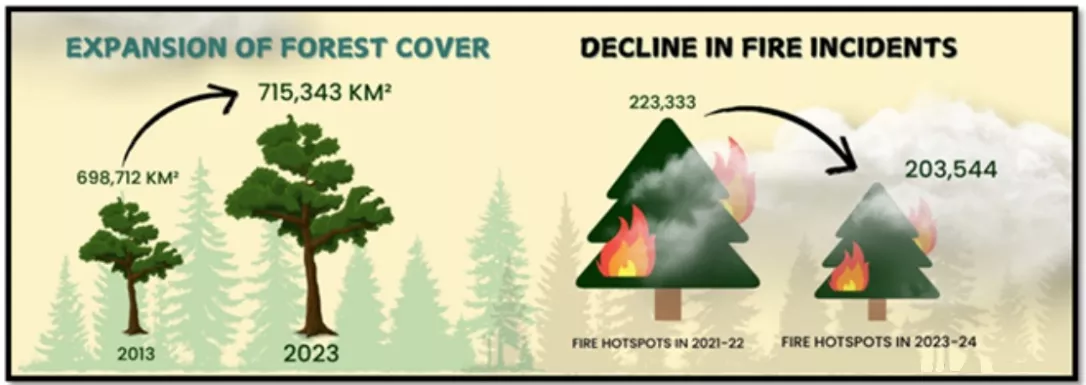 Arunachal Pradesh: 65,882 sq. km
Arunachal Pradesh: 65,882 sq. km- Chhattisgarh: 55,812 sq. km
- Mangrove Cover: India’s mangrove cover is approximately 4,992 sq. km, primarily distributed across the Andaman & Nicobar Islands, Gujarat, Maharashtra, and West Bengal.
- Biodiversity & Protected Areas: India hosts 106 National Parks, 573 Wildlife Sanctuaries, 115 Conservation Reserves, and 220 Community Reserves, reflecting its rich ecological and faunal diversity.
Global Forest Report 2025- India’s Growing Green Footprint
- About the Report: The Global Forest Resources Assessment (GFRA) 2025, released every five years, was unveiled during the Global Forest Observations Initiative (GFOI) Plenary held in Bali, Indonesia.
- About GFOI: The Global Forest Observations Initiative (GFOI) is a flagship programme of the Group on Earth Observations (GEO), promoting the use of Earth Intelligence for sustainable forest monitoring.
- About GEO: The Group on Earth Observations (GEO) is a global partnership comprising governments, academia, organizations, civil society, and the private sector, working to enhance coordinated Earth observation for sustainability.
- India’s Role: India is an active member of GEO, reflecting its commitment to data-driven forest management and climate-resilient ecosystem monitoring.
- Key Highlights of GFRA 2025:
-
- Global Forest Extent: Forests span 4.14 billion hectares, covering 32% of the world’s land area. Nearly half of these lie in the tropical regions, followed by boreal, temperate, and subtropical zones.
- India’s Forest Status: India has risen one rank to 9th globally, representing 2% of the world’s total forest area, and ranks 5th in rubber plantation area.
- Deforestation Trends: Deforestation has declined significantly—from 17.6 million ha/year (1990–2000) to 10.9 million ha/year (2015–2025).
- Natural Regeneration: Over 90% of the world’s forests are now regenerating naturally, signaling improved conservation outcomes.
- Carbon Stocks: Global forest carbon stocks have increased to 714 gigatonnes, with soil retaining the largest share, followed by living biomass, litter, and deadwood.
- Forest Disturbances: Fires dominate in subtropical regions, while insects, diseases, and extreme weather are the main threats in temperate and boreal zones.
|
Key Initiatives and Evolution of Afforestation in India
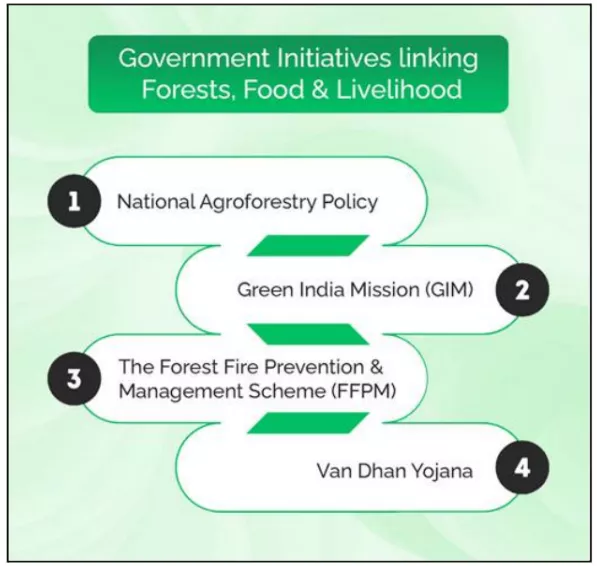
- Early Phases of Afforestation:
- Colonial Approach: Forests treated as economic assets for timber; Indian Forest Acts of 1865 & 1927 focused on state control and exploitation, not regeneration.
- Post-Independence Shift: Emphasis moved to forest conservation and afforestation, though early focus remained on timber and fuelwood needs.
- National Forest Policy, 1952 – Foundation Phase: Aimed to increase forest cover for timber, fuelwood, and industrial needs by promoting tree planting on degraded lands, social forestry, and integration with rural development.
- National Forest Policy, 1988 – Ecological Turn: Marked shift to ecological restoration and people’s participation.
- Goal: Achieve 33% forest & tree cover.
- Focus: Afforestation of degraded lands, watershed management, biodiversity plantations, and Joint Forest Management (JFM) for tribal participation.
- National Afforestation Programme (NAP), 2000: A Centrally Sponsored Scheme for afforestation and eco-restoration through people’s participation. Later merged with Green India Mission (GIM) for better convergence.
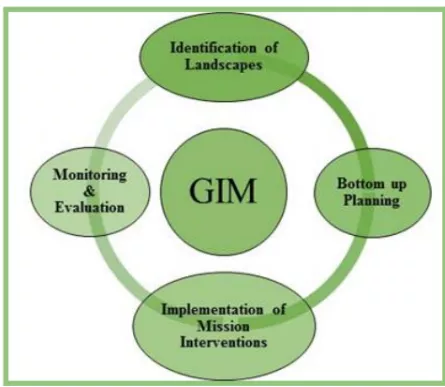 Implemented via a three-tier system:
Implemented via a three-tier system:
- State Forest Development Agency (SFDA) at State level
- Forest Development agency (FDA) at Forest Division level
- Joint Forest Management Committees (JFMCs) at Village level.
- Green India Mission (GIM), 2014: One of the eight NAPCC Missions, aimed at increasing forest/tree cover and restoring degraded ecosystems.
- Targets: Add 5 mha forest/tree cover & improve 5 mha degraded land.
- Benefits: Enhance carbon storage, biodiversity, water management, and 3 million livelihoods.
- Revised GIM (2025): Builds on 2015–21 efforts, which restored 11.22 mha, linked with CAMPA, Agroforestry Policy, and watershed programmes; focuses on Aravallis, Western Ghats, mangroves, and Himalayas.
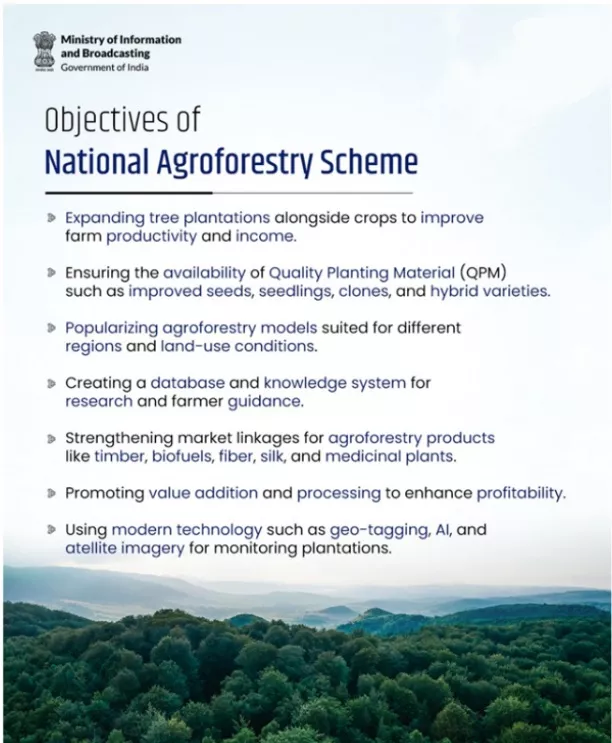 National Agroforestry Policy, 2014: Promotes tree-crop integration for farm income, soil fertility, and climate resilience.
National Agroforestry Policy, 2014: Promotes tree-crop integration for farm income, soil fertility, and climate resilience.
- Ensures Quality Planting Material (QPM) via ICAR-CAFRI and state universities.
- Encourages private sector, price support, and aligns with millet-based farming systems.
- Compensatory Afforestation Fund Act (CAMPA), 2016: Mandates compensatory planting for forest diversion; created National & State CAMPA Authorities with a ₹95,000 crore corpus for afforestation, wildlife protection, and forest infrastructure.
- Forest Fire Prevention & Management Scheme (FFPM), 2017: A Centrally Sponsored Scheme using remote sensing and real-time alerts to prevent and control forest fires. Implements the National Action Plan on Forest Fire and promotes community involvement and technology-based fire management.
- Van Dhan Yojana, 2018: Empowers tribal communities through value addition of Minor Forest Produce (MFPs), skill training, and market linkages, promoting sustainable livelihoods and forest conservation.
- Nagar Van Scheme, 2020: Targets creation of 200 urban forests to enhance urban ecology, green cover, and air quality.
- Mission LiFE (Lifestyle for Environment), 2022: A UN-endorsed global initiative to foster sustainable lifestyles by shifting from a use-and-dispose to reduce-reuse-recycle mindset under the Pro-Planet People (P3) model.
- Forms a core of India’s G20 climate leadership through initiatives like Meri LiFE Portal and Ek Ped Maa Ke Naam.
- MISHTI (Mangrove Initiative for Shoreline Habitats & Tangible Incomes, 2023–24): Launched to restore 540 sq. km of mangroves across 9–11 coastal States/UTs over five years through CAMPA–MGNREGS convergence, the initiative promotes community-led bio-shields and carbon-rich coastal ecosystems, enhancing both climate resilience and livelihood security.
- Aravalli Green Wall Project (2023): Initiated by the MoEFCC to establish a 1,400-km-long and 5-km-wide green belt across Gujarat, Rajasthan, Haryana, and Delhi, aiming to combat desertification, enhance biodiversity, and reduce dust pollution in the National Capital Region.
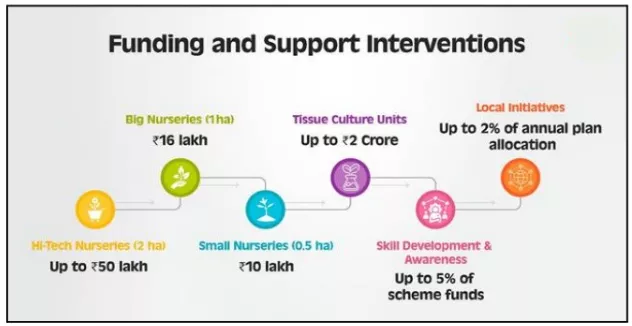 Budgetary & Institutional Support (2025–26):
Budgetary & Institutional Support (2025–26):-
- ₹3,412.82 crore allocated to MoEFCC (increased 9% over 2024–25).
- ₹3,276.82 crore (96%) for revenue expenditure to strengthen field operations.
- Ecosystem Services Improvement Project (ESIP): With World Bank, restoring 1.55 lakh ha in Chhattisgarh & Madhya Pradesh.
- Other Supportive Missions: Complementary initiatives like National Bamboo Mission, Sub-Mission on Agroforestry, and National Mission on Sustainable Agriculture boost tree-based livelihoods and ecological restoration.
- International Day of Forests (March 21): Celebrates global forest importance; the 2025 theme “Forests and Food” underscores forests’ vital role in food security and nutrition.
Notable State-Level Initiatives:
- Tamil Nadu: Achieved a near twofold increase in mangrove cover within three years, significantly enhancing carbon sequestration and coastal resilience.
- Himachal Pradesh: Introduced a biochar programme to generate carbon credits while simultaneously reducing forest fire risks.
- Uttar Pradesh:
- Planted over 39 crore saplings in 2024–25, demonstrating strong local mobilization.
- Exploring carbon market linkages for Gram Panchayats.
- Launched the Green Chaupal platform to foster community-led plantation drives and maintenance through a Gram Harit Nidhi (Village Green Fund) and monthly awareness and micro-planning meetings.
- Odisha: Strengthened Joint Forest Management Committees (JFMCs) by integrating them into planning and revenue-sharing frameworks, improving community participation and compliance.
- Chhattisgarh: Implementing biodiversity-sensitive plantations and reviving barren cattle shelters by planting mahua trees, effectively combining ecological restoration with tribal livelihood enhancement.
|
The Multi-Dimensional Significance Held by Forests
- Ecological and Climate Resilience (The Survival Future):
- Climate Change Mitigation: Forests act as natural carbon sinks, absorbing CO2 and helping India meet its Nationally Determined Contribution (NDC) targets under the Paris Agreement, contributing around 11% to India’s carbon emissions reduction target.
- Under the Paris Agreement, India aims to create an additional 2.5–3 billion tonnes of CO₂ equivalent carbon sink by 2030 through enhanced forest and tree cover.
- Biodiversity Conservation: India’s forests support iconic species like the Bengal tiger and one-horned rhinoceros. Conservation efforts such as Project Tiger and elephant corridors are crucial for maintaining biodiversity.
- Water Security: Forests regulate the water cycle, enhance groundwater recharge, and prevent soil erosion, ensuring sustainable water supply for agriculture and urban areas.
- Air Quality: Acting as the lungs of the environment, forests purify the air by absorbing pollutants like CO2 and particulate matter (PM), improving air quality in both urban and rural areas.
- Economic and Sustainable Development (The Prosperity Future):
- Livelihoods and Employment: Over 250 million people rely on non-timber forest products (NTFPs) like fruits, herbs, and fuelwood, forming the foundation of rural economies and sustainable livelihoods.
- Forest-Based Industry: Sustainable sourcing from forests supports industries such as paper, timber, and pharmaceuticals, ensuring environmental responsibility in production.
- Ecotourism: Ecotourism in forests, like Jim Corbett National Park, generates significant revenue and promotes local economic development, raising awareness about forest conservation.
- Green Accounting: Recognizing the monetary value of ecosystem services—carbon sequestration, water filtration, and biodiversity—in GDP helps drive investment in sustainable forest management and ensures better policy-making.
- Socio-Cultural and Tribal Rights (The Equity Future):
-
- Tribal Rights: The Forest Rights Act (FRA) of 2006 secures tenure and self-governance for tribal communities, granting Community Forest Resource (CFR) rights to manage and sustainably use forest resources.
- Traditional Knowledge: Forest communities possess traditional knowledge vital for sustainable forest management and conservation. Integrating this knowledge with modern techniques is essential for long-term forest health.
- Gender Equity: Women play a pivotal role in the collection and processing of NTFPs, contributing to socio-economic development. Ensuring gender equity strengthens forest conservation and community development.
Constitutional, SDGs & Global Provisions for Afforestation
| Category |
Provision |
| Constitutional Provisions |
- Article 48A – Directive Principles of State Policy: Mandates the state to protect and improve the environment, including forest conservation.
- Article 51A(g) – Fundamental Duties: Encourages citizens to protect and improve the natural environment, including forests.
- Union and State List (Seventh Schedule): Central and State governments can legislate and implement afforestation policies and forest conservation.
|
| Sustainable Development Goals (SDGs) |
- SDG 13 – Climate Action: Afforestation helps in carbon sequestration, contributing to India’s NDCs under the Paris Agreement.
- SDG 15 – Life on Land: Focus on biodiversity conservation, restoring ecosystems, and expanding forest cover through afforestation.
- SDG 6 – Clean Water and Sanitation: Forests regulate water cycles, recharge groundwater, and prevent soil erosion, ensuring sustainable water resources.
- SDG 8 – Decent Work and Economic Growth: Afforestation supports green jobs, livelihoods from NTFPs, and forest-based industries.
|
| Global Provisions |
- UNFCCC – Paris Agreement: India’s commitment to increase carbon sinks through afforestation to meet climate mitigation goals.
- UN Decade on Ecosystem Restoration (2021-2030): Promotes ecological restoration and the afforestation of degraded lands to mitigate climate change.
- Convention on Biological Diversity (CBD): Protects global biodiversity by promoting forest conservation and afforestation.
- Global Forest Observations Initiative (GFOI): Earth observation to track forest cover changes and enhance afforestation strategies globally.
- UNEP – United Nations Environment Programme: Encourages afforestation to mitigate climate change, enhance ecosystem services, and fight desertification.
|
Challenges to Afforestation and Ecosystem Restoration
- Limited Community Participation: Despite the Forest Rights Act (2006) empowering local communities, many afforestation programs bypass stakeholders, reducing community ownership and hindering the sustainability and effectiveness of restoration efforts.
- Monoculture Plantations: While tree planting has increased, much of the expansion focuses on monoculture plantations, which lack biodiversity and fail to contribute to long-term ecological sustainability.
- Deforestation and Land Conversion: Illegal logging, urbanization, and industrialization continue to degrade existing forests, undermining afforestation efforts and hindering the expansion of forest cover.
- Climate Vulnerability: Rising temperatures, wildfires, and extreme weather events stress forests, with 2025 IIT Kharagpur study showing a 12% decline in photosynthetic efficiency due to climate change, limiting their carbon sequestration potential.
- Implementation Gaps: Institutional capacity and lack of expertise in forest departments hinder the effective implementation of afforestation programs, preventing optimal ecological restoration and monitoring.
- Forest Fire Management: Forest fires continue to pose significant risks, particularly in dry regions, despite the use of remote sensing technology and fire prevention measures, resulting in the loss of biodiversity and the degradation of forest ecosystems.
- Ecological Design: Previous afforestation efforts heavily relied on monocultures like eucalyptus and acacia, which were fast-growing but ecologically damaging.
- Financial Constraints: Despite a ₹95,000 crore fund under CAMPA, the utilization of funds has been inconsistent, with Delhi, for example, spending only 23% of its approved allocation between 2019 and 2024.
Way Forward
- Ecologically Sensitive Afforestation: Shift from monoculture plantations to native species and biodiversity-based restoration to ensure long-term ecological sustainability and resilience against climate change.
- Enhanced Community Engagement: Strengthen community-driven forest management by ensuring active participation of tribal and local communities in decision-making, aligning forest conservation with socio-economic needs.
- Improved Monitoring Systems: Implement real-time monitoring using remote sensing and satellite technology to track forest health, survival rates, and fund utilization, ensuring greater transparency and accountability.
- Innovative Financing Models: Leverage carbon credits, private investments, and global partnerships to secure long-term funding for afforestation programs, supplementing government budgets and increasing financial sustainability.
- Capacity Building and Skill Development: Focus on training forest staff and local communities in ecological restoration, sustainable forest management, and climate-resilient practices to build capacity at both the policy and implementation levels.
- Focus on Climate Resilience: Integrate climate change adaptation strategies into afforestation efforts, ensuring that restoration projects enhance carbon sequestration while improving forests’ ability to withstand extreme weather events.
- Strengthening Policy Implementation: Ensure better utilization of funds, particularly CAMPA, by increasing monitoring, accountability, and integrating adaptive management strategies in afforestation programs.
- Ecological Restoration: The revised Green India Mission (GIM) prioritizes native species and site-specific restoration, promoting biodiversity enhancement and climate resilience.
Conclusion
Forests are India’s ecological capital and the cornerstone of Viksit Bharat @2047. The Green India Mission 2025, targeting 25 million hectares of restoration, embodies this vision. With community participation, native species, and innovative financing, India can pioneer a global model of climate resilience, biodiversity revival, and sustainable livelihoods.
![]() 8 Nov 2025
8 Nov 2025

 Arunachal Pradesh: 65,882 sq. km
Arunachal Pradesh: 65,882 sq. km
 Implemented via a three-tier system:
Implemented via a three-tier system:
 National Agroforestry Policy, 2014: Promotes tree-crop integration for farm income, soil fertility, and climate resilience.
National Agroforestry Policy, 2014: Promotes tree-crop integration for farm income, soil fertility, and climate resilience.
 Budgetary & Institutional Support (2025–26):
Budgetary & Institutional Support (2025–26):
